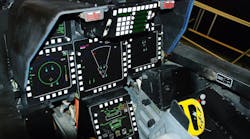By Michael R. Palis
Common electronics failures are caused by temperature-related effects that can manifest by geometrical effects as we shrink device and transistor sizes, by material effects, and by the vulnerabilities of silicon. While good thermal management reduces thermally induced failures, it also may enhance or improve on device performance.
These needs and pressures typically happen where designers mandate high performance in small packages, as is occurring in military, telecommunications, and commercial products. Because of these needs, managed and advanced cooling techniques are necessary to keep these products within their operating specifications.
The conventional techniques used in chassis design rely heavily on forced convection of the dissipated energy to the ultimate environment. These techniques include: efficient and high-capacity air movers, embedded heat pipes and heat spreaders, and optimized compact heat exchangers. Also necessary are hybrid dual-phase systems such as spray-cooling techniques, pulse tube coolers, jet impingement, and emersion cooling.
All of these cooling techniques need to be a balance against the customer’s system to meet performance goals and size, weight, and power (SWaP) expectations.
Relatively high-capacity air movers may appear to be an adequate solution, yet there are physical and practical limits for forced convective heat transfer that have been published in many heat-transfer articles. To apply a high-capacity air mover, the designer needs a dramatic increase either to the size of the air mover or to the power input. Both approaches result in increased power consumption and airborne noise.
The vast majority of the circuit card assemblies available for integration into high-level systems rarely publish this type of information. Various general and specialized industry trade groups, CP-TA and PICMG, have seen the trend in increasing power and component density and are adding requirements to published industrial standards to include this information. Incorporation of this data for all circuit card assemblies will enable system integrators and chassis designers to choose air movers wisely.
Hybrid methods of transferring heat from circuit card assemblies to the ambient environment involve using one or more coolants or modes of heat transfer to move heat to large areas. Heat-transfer methods can include a heat pipe, a micro-channel heat spreader, and liquid-cooled cold plates.
These cooling methods all reduce the temperatures of the devices, but add levels of system complexity—or even leaks—that can influence the reliability, costs, size, weight, and power. Most heat pipes and heat spreaders contain volatile and chemically active fluids that can contaminate or damage electronics and circuit card assemblies. Careful selection and evaluation can keep these risks to a minimum.
Another approach involves separating the ambient environment and the operating electronics to keep out contaminants like sand, dust, combustion particles, and other hydrocarbons. A convenient way to do this is using compact air-to-air heat exchangers.
A compact heat exchanger moves heat from one fluid to another. These fluids are separated by a common wall, which in various ways is able to move heat from hot liquid, to solid, and back to relatively cool liquid and ultimate rejection to the overall ambient environment. Due to the relative heat-transfer properties of air, the sizes of these heat exchangers can vary largely depending on the goals for the overall system packaging solution.
From review of various compact heat-exchanger geometries, the design features have been categorized into three major figures of merit (FOM) for determination of the optimal compact heat exchanger for the specific design application.
These three figures of merit are:
- Maximized heat transfer/minimized pressure drop, where size and weight are lesser concerns than the thermal performance of the system, resulting in the highest heat transfer for the input power to maintain this performance level; this type of compact heat exchanger is characterized by straight parallel plates represented by extruded heat sinks or straight folded fin heat sinks;
- Size, represented by the traditional “PIN-FIN” heat sink arrangement, where individual square, round, or custom cross-sectional shapes are placed on a heat-spreading plate attached to the heat-generating device; fins can be either in an even grid pattern or an alternating row pattern where the individual fins are offset from the proceeding row; and
- Weight, represented by louvered fins being present in the heat sink.
For the cases where size and weight are optimized for the system solution, the flow resistance of these configurations is higher than that of the straight parallel plate and will require relatively high-capacity air movers to remove the same amount of heat in the optimized conditions. This is the tradeoff of design performance versus size and weight that is needed to be performed on all thermal solutions to provide a balanced solution.
A third class of thermal management that has been getting consideration and exposure involves either single- or dual-phase liquids for providing the energy transport. These systems range from single phase liquid cooling systems—similar to the cooling system in the personal automobile—to dual phase systems where heat energy is transported through changing phase of the liquid to a vapor phase.
In the latter situation, large amounts of energy must be extracted from the application to turn the fluid to become a vapor, which can move to another region on the platform for condensation and heat rejection.
These hybrid thermal-management systems are spray cooling, jet impingement, emersion cooling, and pulse tube cooling.
Spray cooling involves a dielectric liquid sprayed directly on or in the area of hot components. The spray changes phase by absorption of the heat energy and is condensed in another area of the system.
Jet impingement involves high-pressure velocity fluid that flows directly onto heat-generating surfaces.
Emersion cooling submerges electronic components into high dielectric fluids that are compatible with the operation of the electronic components.
Pulse tube cooling draws cooling fluid onto a compression and expansion cycle to extract heat energy from the fluid as the fluid is expanding during release at a nozzle.
These hybrid techniques all require compression machinery, pumps, fans, and compressors, and consume additional volume and require additional power to be applied in the system.
These advances in cooling performance and thermal management reduce thermally induced failures, and enhance or improve on the performance of these same electronic devices, but come with system-level tradeoff considerations that may negatively influence the final size, weight, and power.
These are the parameters of the system thermal solution that needs top be evaluated prior to selection of one of these advanced thermal techniques for the ever-increasing power dissipation in modern electronics equipment.
Michael R. Palis is senior thermal engineer at Hybricon Corp. in Ayer, Mass. Contact the company online at www.hybricon.com.


